
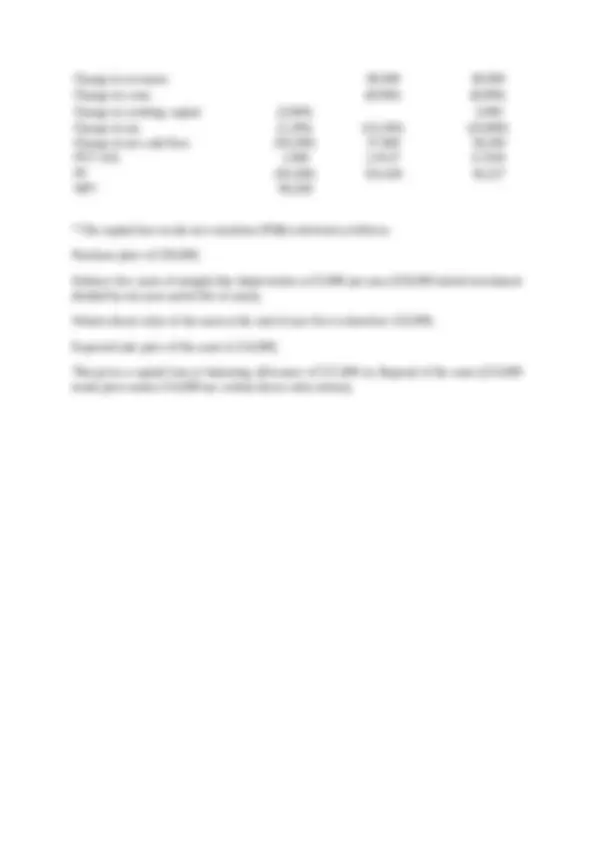
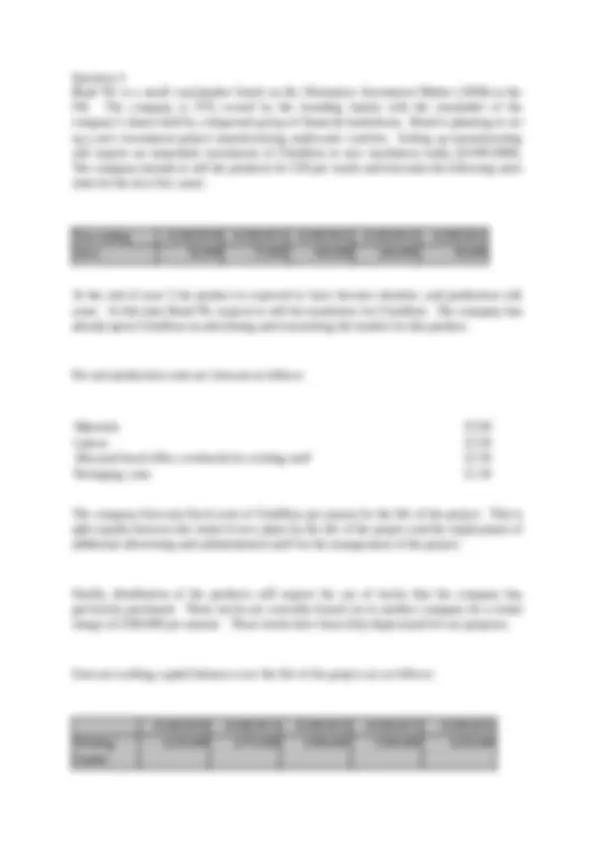
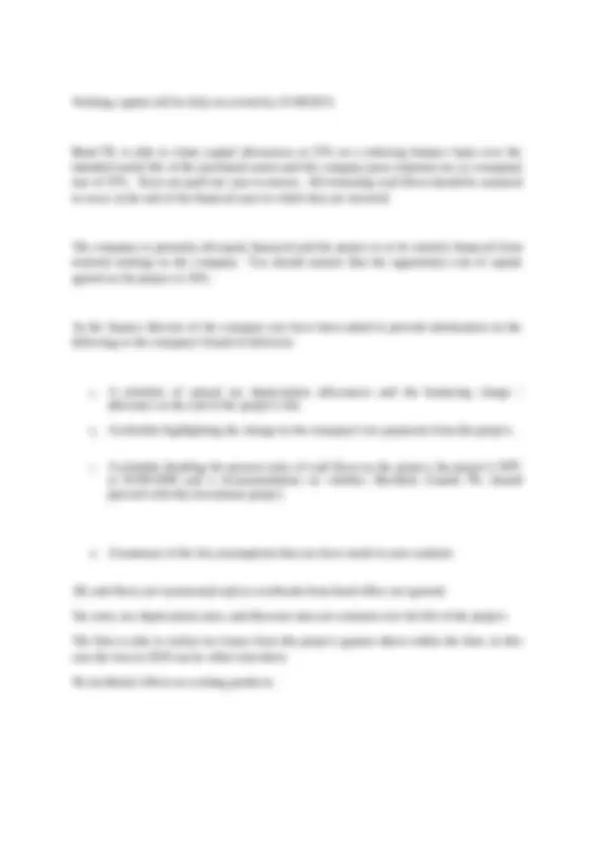
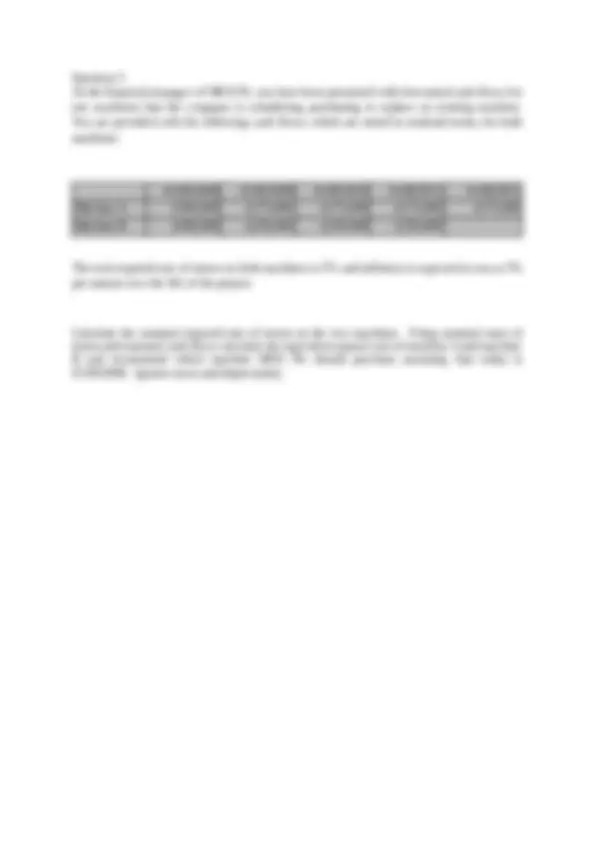
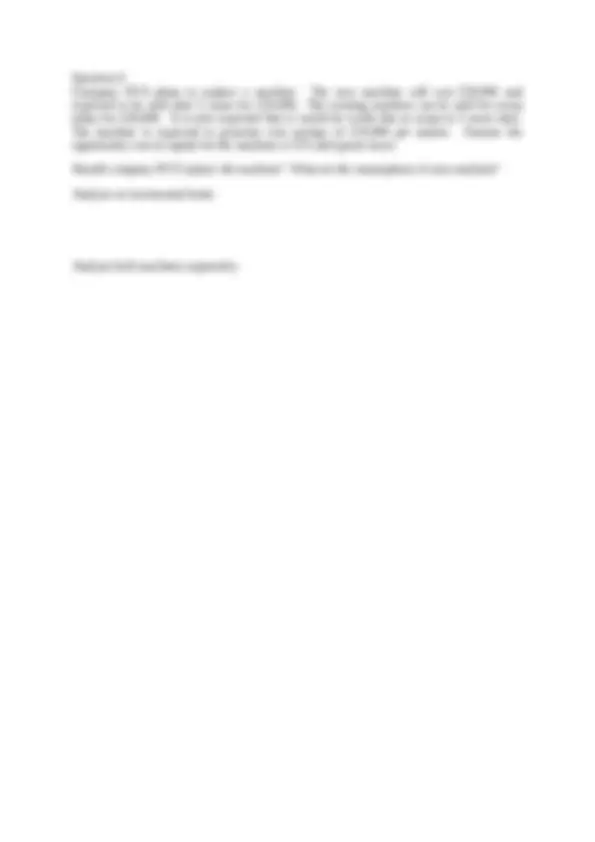
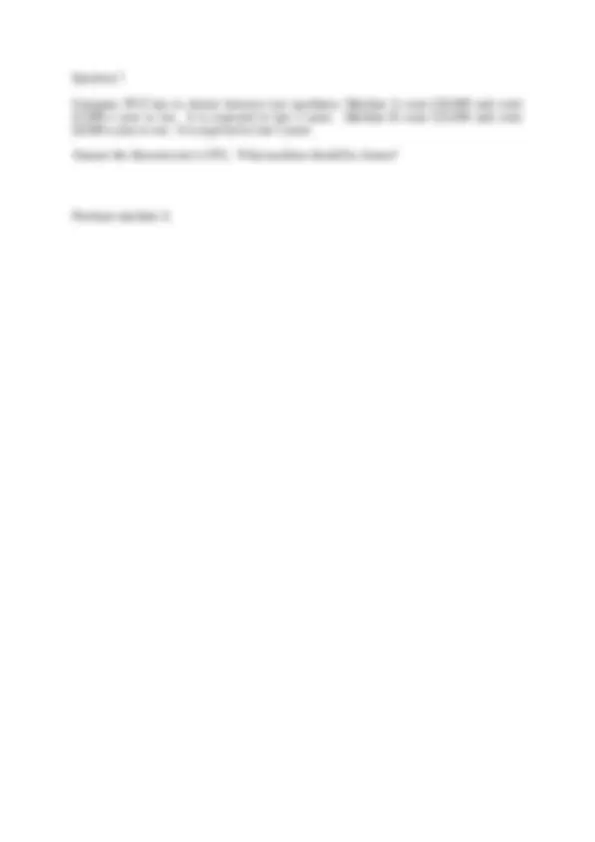


Study with the several resources on Docsity

Earn points by helping other students or get them with a premium plan


Prepare for your exams
Study with the several resources on Docsity

Earn points to download
Earn points by helping other students or get them with a premium plan
Community
Ask the community for help and clear up your study doubts
Discover the best universities in your country according to Docsity users
Free resources
Download our free guides on studying techniques, anxiety management strategies, and thesis advice from Docsity tutors
Tutorial Week 3Tutorial Week 3Tutorial Week 3
Typology: Exercises
1 / 11

This page cannot be seen from the preview
Don't miss anything!







AG215 Business Finance, Week 3 Tutorial
Tutorial sessions to cover questions 1 and 2. Remaining materials for revision purposes and solutions provided online.
Question 1
Rogers Ltd is evaluating two different pieces of production machinery to replace an old existing machine. Model A costs £360,000, will last for three years. Annual operating expenses will be £80,000 in year 1 but will increase with inflation at 3% per annum. Model B costs £440,000 and will last for four years. Model B has annual operating expenses of £85,000 in year 1 and but expenses will increase at a higher rate of 5% per year
Both machines should be depreciated on a straight-line basis over their expected useful lives. The company pays corporate tax at a marginal rate of 30% and tax is paid during the year in which it arises. Both machines are evaluated with a nominal discount rate of 12%. Compute the equivalent annual cost (EAC) for both machines and recommend which one the company should go ahead with.
Should choose machine A as it has the lower equivalent annual cost.
Question 2
The management of Tumble Manufacturing is considering replacing one of its machines with a more technically advanced model capable of producing an improved product. This will make it possible for the company to push up its price by £2 per unit, from £18 to £20. Sales can also be expected to increase from 10,000 to 12,000 units per annum as a result of the product improvement.
The new machine would also produce some cost savings per unit. The company cost accountant has estimated the changes in cost and these are given below. You recognise from past experience that the cost estimates produced by the cost accountant need to be evaluated very carefully as he does not always identify those costs that are relevant for decision taking. The existing machine was bought ten years ago and will be sold for scrap for £4,000 even though it is still in good working order. It is fully depreciated for tax purposes. The new machine would cost £50,000 and
under the current tax regime would have to be depreciated on a straight-line basis over ten years. However, the company plans to discontinue the manufacture of this product after five years. At this time the new machine would be sold, but is expected to realise no more than £14,000. The net working capital would increase as a result of the expansion of activity from £26,000 to £29,000.
Existing New machine (output = 10,000) (output = 12,000) Raw materials 30,000 35, Wages 60,000 62, Other expenses 10,000 11, Share of general overheads* 15,000 15, Depreciation - 5, Total costs 115,000 128, Cost per unit 11.50 10.
If the company pays tax on profits at 30 per cent, and its cost of capital 14 per cent after tax, determine the net present value of the investment. Set out your calculations clearly and specify the critical assumptions.
Change in Profit/Loss Account 0 1 → 4 5 Changes in revenues 60,000 60, Change in materials (5,000) (5,000) Change in wages (2,000) (2,000) Other expenses (1,000) (1,000) Increase in depreciation (5,000) (5,000) Capital gain/loss (OM) 4, (NM) (11,000) *
Change in profit 4,000 47,000 36, Change in tax (1,200) (14,100) (10,800) Change in Net Cash Flow 0 1 → 4 5 Resale proceeds (OM) 4000 (NM) 14,000 (1) Investment (50,000)
Question 3 Bond Plc is a small watchmaker listed on the Alternative Investment Market (AIM) in the UK. The company is 55% owned by the founding family with the remainder of the company’s shares held by a dispersed group of financial institutions. Bond is planning to set up a new investment project manufacturing underwater watches. Setting up manufacturing will require an immediate investment of £5million in new machinery today (01/09/2009). The company intends to sell the products for £50 per watch and forecasts the following sales units for the next five years:
Year ending 31/08/2010 31/08/2011 31/08/2012 31/08/2013 31/08/ Sales 50,000 75,000 100,000 100,000 50,
At the end of year 5 the product is expected to have become obsolete, and production will cease. At this time Bond Plc expects to sell the machinery for £1million. The company has already spent £1million on advertising and researching the market for this product.
Per unit production costs are forecast as follows:
Materials £5. Labour £3. Allocated head office overheads for existing staff £2. Packaging costs £1.
The company forecasts fixed costs of £1million per annum for the life of the project. This is split equally between the rental of new plant for the life of the project and the employment of additional advertising and administration staff for the management of the project.
Finally, distribution of the products will require the use of trucks that the company has previously purchased. These trucks are currently leased out to another company for a rental charge of £500,000 per annum. These trucks have been fully depreciated for tax purposes.
Forecast working capital balances over the life of the project are as follows:
Working Capital
Working capital will be fully recovered by 31/08/2015.
Bond Plc is able to claim capital allowances at 25% on a reducing balance basis over the intended useful life of the purchased assets and the company pays corporate tax at a marginal rate of 35%. Taxes are paid one year in arrears. All remaining cash flows should be assumed to occur at the end of the financial year in which they are incurred.
The company is presently all-equity financed and the project is to be entirely financed from retained earnings in the company. You should assume that the opportunity cost of capital agreed on the project is 18%.
As the finance director of the company you have been asked to provide information on the following to the company’s board of directors:
a. A schedule of annual tax depreciation allowances and the balancing charge / allowance at the end of the project’s life.
b. A schedule highlighting the change in the company’s tax payments from this project.
c. A schedule detailing the present value of cash flows on the project, the project’s NPV at 01/09/2009 and a recommendation on whether Aberdeen Granite Plc should proceed with this investment project.
d. A summary of the key assumptions that you have made in your analysis.
All cash flows are incremental and so overheads from head office are ignored.
Tax rates, tax depreciation rates, and discount rates are constant over the life of the project.
The firm is able to realize tax losses from this project against others within the firm; in this case the loss in 2010 can be offset elsewhere.
No incidental effects on existing products.
Variable Costs -3600 -3600 -3600 -3600 - Fixed Costs Production -600 -600 -600 -600 - Patent Value - Foregone rents Investment - Equipment Recovery Value 500 General Overheads Working Capital -1800 1800 Taxation 150 -510 -510 -510 -510 - Net Cash Flow -10150 2790 2790 2790 2790 4940 Present Value Factor 1.0000 0.8772 0.7695 0.6750 0.5921 0. Present Value -10150 2447 2147 1883 1652 2566 Net Present Value 545
b. Explain that is meant by sensitivity analysis and determine the sensitivity of the investment’s NPV to a 10% reduction in the expected price from the assumed value of £25 per unit.
Change in Revenues -750 -750 -750 -750 - Change in Profit -750 -750 -750 -750 - Change in Tax 225 225 225 225 225 Change in NCF -525 -525 -525 -525 - Present Value Factor 0.8772 0.7695 0.6750 0.5921 0. Present Value -461 -404 -354 -311 - Change in NPV -
Sensitivity analysis does not need to repeat the entire work; simply focus on the variables from the above working that actually change in response to a change in revenues.
Question 5 As the financial manager of MLK Plc you have been presented with forecasted cash flows for two machines that the company is considering purchasing to replace an existing machine. You are provided with the following cash flows, which are stated in nominal terms, for both machines:
Machine A -£500,000 -£175,000 -£175,000 -£175,000 -£175, Machine B -£400,000 -£250,000 -£250,000 -£250,
The real required rate of return on both machines is 5% and inflation is expected to run at 3% per annum over the life of the project.
Calculate the nominal required rate of return on the two machines. Using nominal rates of return and nominal cash flows calculate the equivalent annual cost of machine A and machine B and recommend which machine MLK Plc should purchase assuming that today is 01/09/2008. Ignores taxes and depreciation.
Question 7
Company XYZ has to choose between two machines: Machine A costs £20,000 and costs £5,000 a year to run. It is expected to last 3 years. Machine B costs £25,000 and costs £8,000 a year to run. It is expected to last 5 years.
Assume the discount rate is 10%. What machine should be chosen?
Purchase machine A
Question 8
An automated packaging machine can process 3,000 units per annum, has a working life of six years and no recovery value. The machine costs £20,000 and the company’s required rate of return on investments of this nature is 14 per cent.
Determine the annual cost of using the machine over its six year working life and the capital cost of packaging one unit.
Annual cost of machine = £20,000 / PVAF6/0. = £20,000 / 3.8887 = £5, Cost per unit = Annual cost / 3,000 units = £5,143/3,000 = £1.
Question 9
The management of Ultra Ltd. is attempting to price a new product. The company anticipates sales of 40,000 units per annum, variable costs per unit are expected to be £25.00 and the annual fixed costs are expected to be £600,000 per annum. The fixed costs do not allow for the expenditure on machinery required to produce the product. This will cost £1,400,000 and the finance director has been asked to determine the equivalent annual cost of the machinery if the machinery has a working life of four years and the cost of capital is 14 per cent.
On the basis of the annual cost of machinery estimate and the other costs specified determine the per unit cost of the new product.
Annual equivalent cost = Machinery Cost / PVAF4/0.0. = V 4 / PVAF4/0. = 1,400,000 / 2. = 480,488. Capital cost per unit = 480,488.73/40,000 = £12 approx Overall unit cost = 12+25+600/40= £